Recreating the Brisbane Band of 1857
By Simon Miller, Library Technician, State Library of Queensland | 12 March 2013
BRISBANE BAND.
THE public are respectfully informed that the arrangements for giving regular performances have now been completed, and that the FIRST PERFORMANCE OF THE BRISBANE BAND will take place in the Botanic Gardens, on MONDAY AFTERNOON, at four o'clock, and terminate at six. The second performance will take place on SATURDAY AFTERNOON, at the same hour. The performances will be repeated every MONDAY and SATURDAY, from 4 to 6 o'clock.
In announcing their programme they hope to have the attendance of all who can make it convenient to attend.
The Instruments consist of a Clarinet, Cornet, Sextuba and Trombone.
PROGRAMME:
1. Grand March-Annie Laurie .. BOSSINI.
2. Aria from Romeo and Juliet.... BELLINI.
3. Carlslust Polka.... KESSLER.
4. Cavitina from Anna Pollena .... DONIZETTIE.
5. Faust Waltz.... D'ALBERT.
6. Cavitina from Attilla....VERDY.
7. Como Quadrille.... D'ALBERT.
8 Cavitina from Robert Diavolo .. MEYERBEER.
9. Victory Galop.....TINNY.
10. French and English Alliance National Air....H. RUSSEL.
11. God Save the Queen.
ADMISSION FREE.
ANDREW SEAL.
AUGUSTE SEAL.
F. CRAMER.
G. CRAMER.
September 19, 1857.
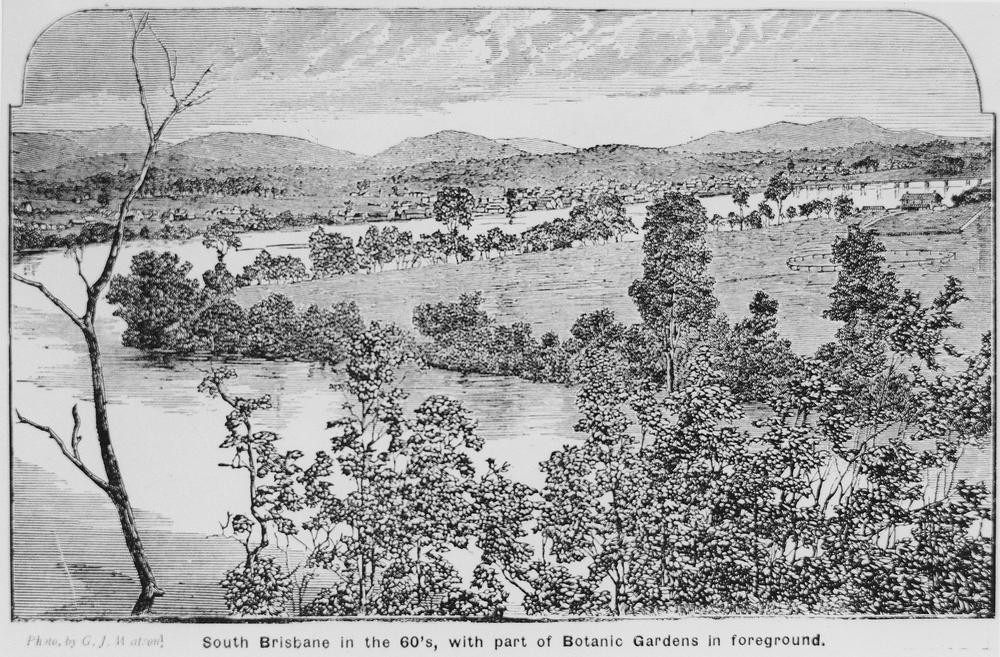
To coincide with the opening of the State Library’s exhibition Live! Queensland band culture we were inspired to attempt to recreate this concert advertised in the Moreton Bay Courier in 1857. Before embarking on a library career, I was a musician in the Australian Army, and continue to play in bands and orchestras around Brisbane. I was approached to arrange the music for the concert and have taken on the project with great enthusiasm.
This concert was the first in a series organised by Mr. R.R. Mackenzie (later Sir Robert Mackenzie, first Colonial Treasurer of Queensland and later Premier). He had found a group of German professional musicians working in Sydney. Andrew Seal (born Andreas Siegel) and his older brother Auguste were born in Wiesbaden, the sons of a prominent bandmaster, who evidently trained them well. At the age of 14 Andrew Seal went to London where he obtained work in the orchestra of the Princess Theatre. Here he caught the attention of the great tragic actor G.V. Brooke who was planning a tour of Australia. Brooke persuaded Andrew Seal to accompany him along with his brother and the four Cramer brothers, also German musicians.
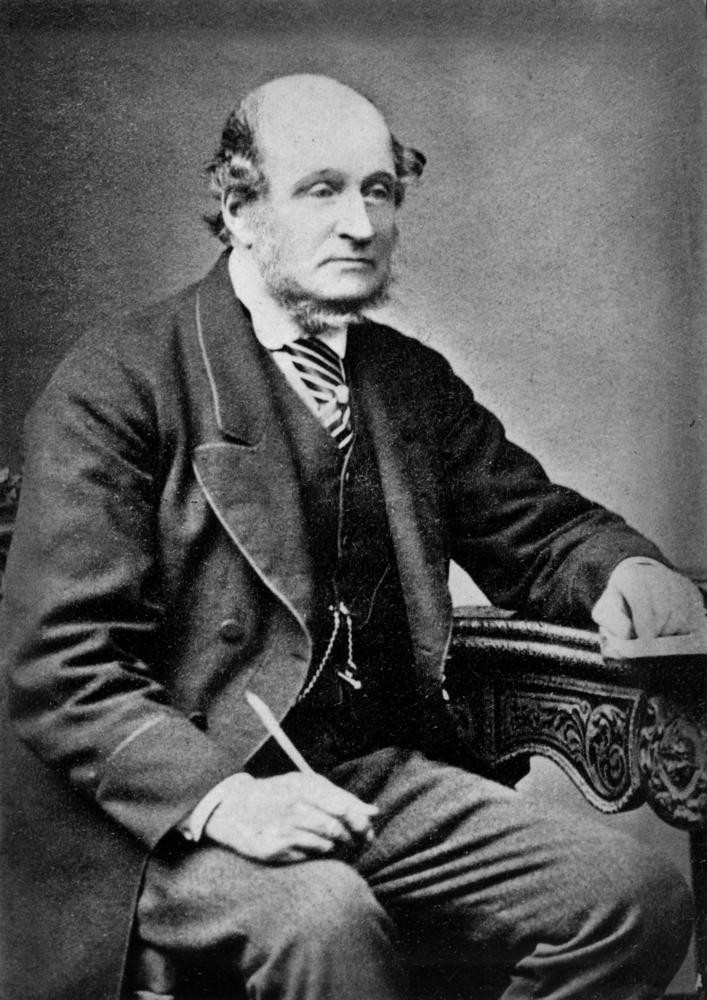
Mackenzie engaged the Seal brothers and two of the Cramers to come to Brisbane for a series of concerts to be paid for by subscription. After the early success of the concerts Mackenzie induced the musicians to stay in Queensland and found work for them. Frederick (or Ferdinand) Cramer, the clarinet player, moved to Ipswich and took up work on the railways. He married and had nine children, as well as conducting the Ipswich Volunteer Band.
His brother Ernest was evidently a fine flute player, but all these musicians were versatile and played a number of instruments. Ernest seems to have eventually returned to Sydney. A notice in the Sydney Morning Herald of January 1913 gives us some information about him.
Mr. and Mrs. Ernest Cramer, of Park road, Camperdown, celebrate their golden wedding to-day. Mr. Cramer was formerly a bands-man aboard the London, during the Crimean War. He took part in the bombardment of Sevastopol, and met Florence Nightingale at Scutari.
Auguste Seal was the older Seal brother but deferred to his younger sibling’s leadership in the band. Auguste often played the double bass in orchestras around Brisbane when he wasn’t playing the trombone with his brother. He is described in one account as a very timid man although there is a court report from 1858 in which both the Seal brothers “were admonished and discharged for using threatening language.”
Andrew Seal was the leader of the group, played the cornet, and also arranged all of the music. He too was a versatile musician, playing violin and viola as well as the cornet and other brass instruments. He became a prominent figure in Brisbane’s musical scene, opening a music shop in Queen Street, teaching extensively, and forming and conducting bands, both military and civilian. Professor Seal, as he became universally known, could justifiably be called the father of band music in Queensland as described in his obituary in 1904.
Of Mr Seal it might have been truly said that he was the father of Queensland brass bands, for most of the local bandsmen have either received some of their training at his hands, or from pupils whom he has tutored. … A man of much talent and activity, the late bandmaster found time, besides performing his duties as conductor, to compose several pieces of music. He was of a generous nature, and he has been a favourite with those with whom he has been associated during his forty-five years in Queensland.
His funeral, described in the Brisbane Courier, was very well attended with many “prominent musicians of the city” being present. The funeral procession “was headed by the Police Band playing the" Dead March" in " Saul." During the procession to the Toowong Cemetery a massed band of musicians from the various civil and military bands played Beethoven's " Funeral March."
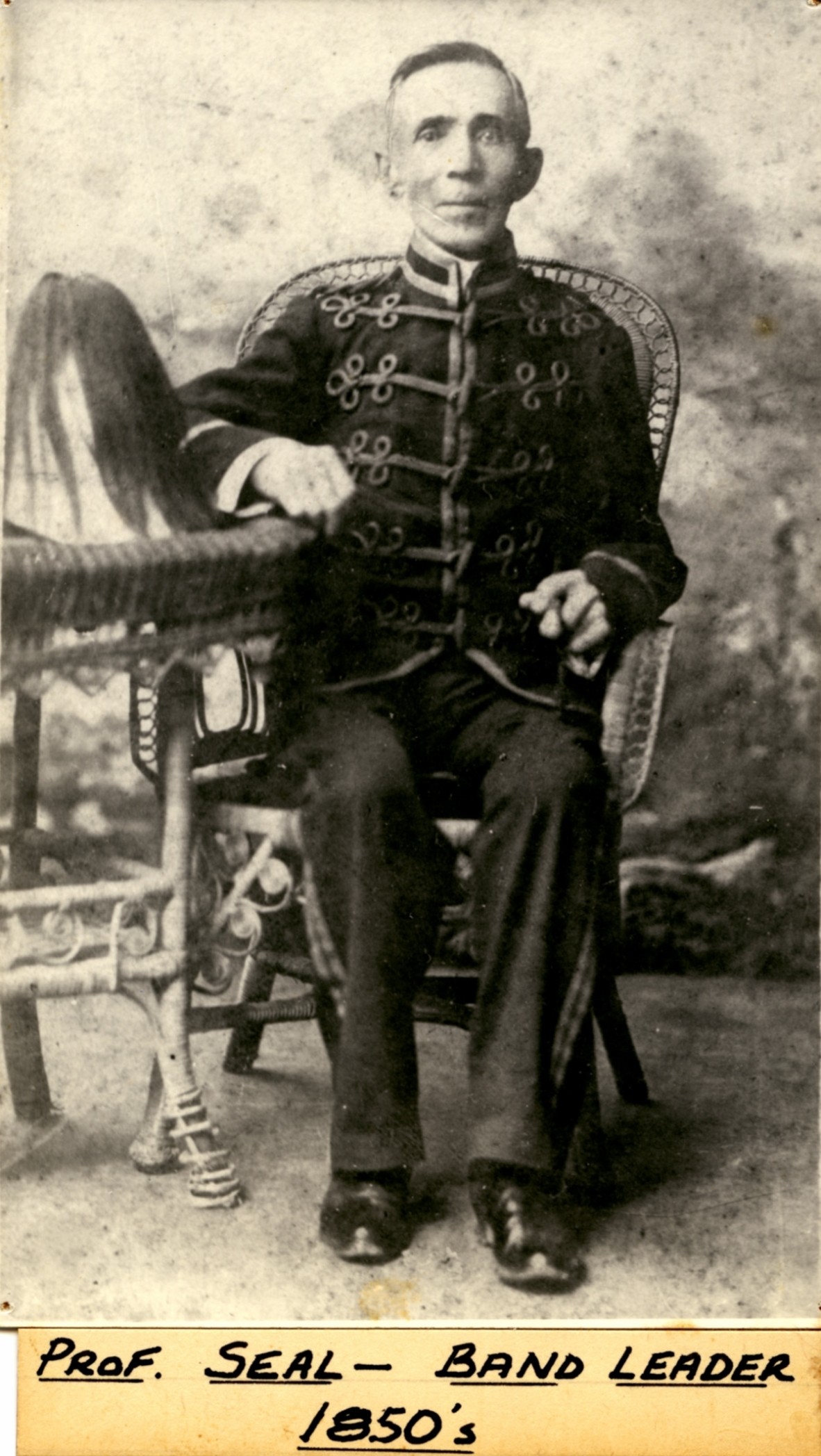
In reproducing the concert the first puzzle to be solved was in the instrumentation. The clarinet, cornet and trombone are clear enough and those instruments remain little changed since the mid-19th century. The ‘sextuba’ was a mystery that was only partially resolved by realising that the name had been misspelled and should have been ‘saxtuba’.
The saxtubas were a whole family of instruments invented by that most creative instrument maker Adolf Sax. Sax was a Belgian instrument maker, living in Paris, whose inventive brain came up with the saxophone and the saxhorns, which in a more modern form make up the bulk of brass bands. Both of these instruments were made in families of seven or eight different sized instruments ranging from sopranino to contrabass. This was also the case with the saxtubas, an experimental design that never really took off.
Their design was based on the shape of ancient Roman instruments, the cornu and tuba. They had a curving shape with bells facing forwards over the players shoulder. Although Sax first came up with the design for the instruments in 1845 he doesn’t seem to have built any until 1852 when they first appeared in an opera ‘The Wandering Jew’ by Fromental Halevy. The opera was not a success and when it disappeared it seams that the saxtubas largely vanished as well. It is a mystery how an obscure instrument, first made only five years earlier for an opera in Paris, turned up in the hands of a German musician in Brisbane in 1857.
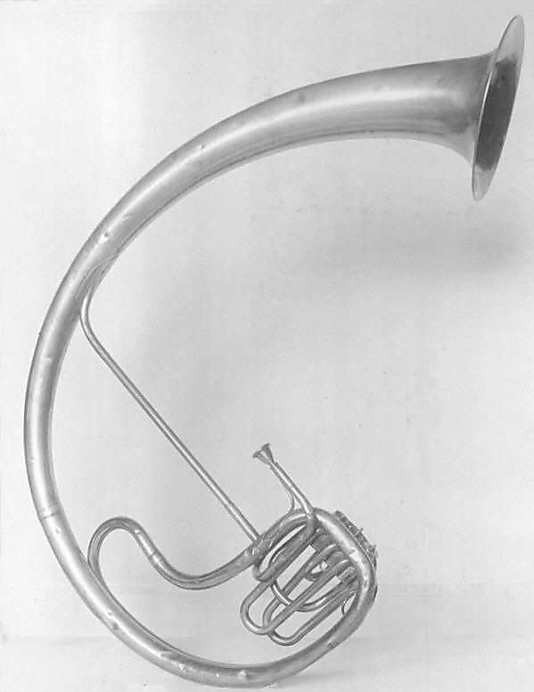
One practical difficulty for us is that there are only a very few saxtubas left in the world hidden away in various museums. Another difficulty is that there is no indication of which of the family of instruments, that were made in at least eight different sizes, was the one employed. My solution was to substitute an instrument that is known in England as the tenor horn and in Europe and America as the alto horn or Althorn. This is a member of the saxhorn family and its range, between that of the cornet and trombone, would balance the ensemble and match the position that it is listed in the advertisement. This also had the advantage that I could play the tenor horn part myself.
Having settled the instrumentation it was then necessary to find the music from the original program. We are fortunate that the Royal Queensland Historical Society is in possession of original part books hand written by Professor Seal for a larger ensemble of eight instruments dating from only a few years after this first concert and including the four operatic selections from the original concert. I was able to transcribe the parts into a full score in a music notation program and then, based on the score, arrange the music for the smaller group.
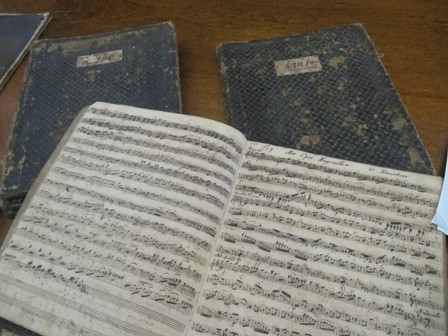
This left a variety of marches and dances to be located. The Faust waltz was discovered in a version for piano and the Como Quadrille was eventually found at the National Library in a version for cornet and piano. The Grand March Annie Laurie by ‘Bossini’ we were not able to find, but we did come across another Annie Laurie March for piano of the same period which I have arranged for the concert. The Victory Galop of Tinny was not found but I did discover a copy of the Overland Mail Galop by Charles D’Albert which featured in the second concert program of the Band performed on September 26th 1857 which serves as a reasonable substitute. The Carlslust Polka by Kessler has proved elusive and I have substituted the Clarinet Polka which, although probably not composed as early as 1857, is a great favourite of German bands everywhere. God Save the Queen was not difficult to find but the French and English Alliance National Air is one that we have been able to discover nothing about.
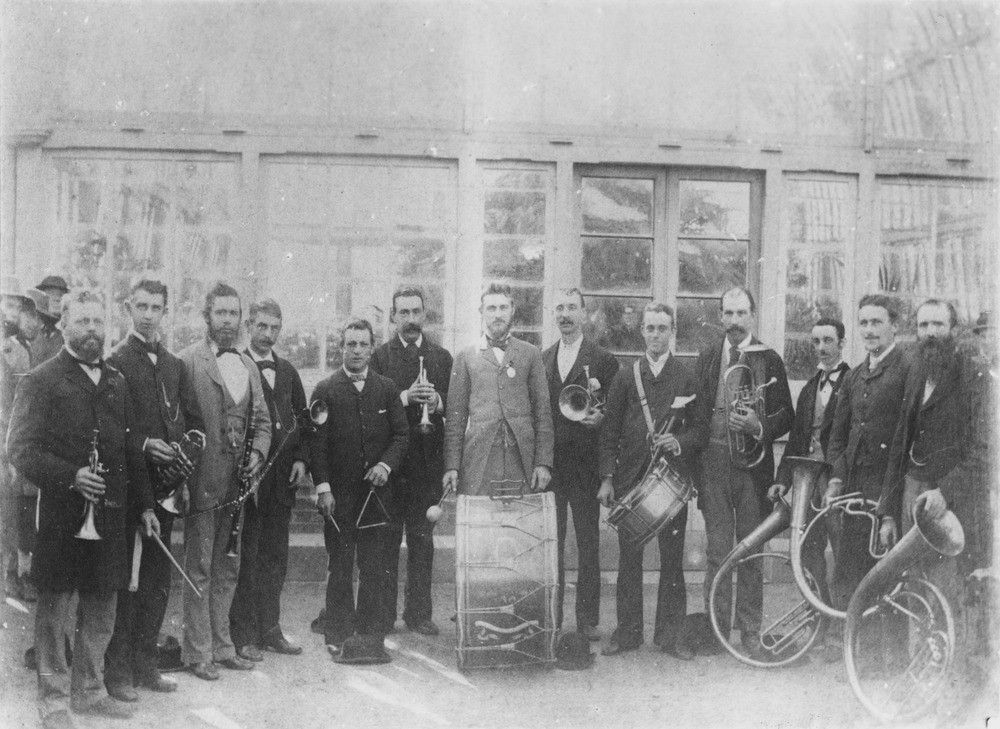
This photograph is one of the earliest we have of a band in Brisbane. The burly cornet player on the left, holding a conductor's baton is certainly not Professor Seal who was a very small, dapper gentleman. Could the clarinet player, 3rd from the left be Frederick Cramer, who was described at the time of the first band concert as a muscular chap around six feet tall? What of those curling instruments on the right? Are they various sizes of saxtuba? There were a number of bands active in the 1880s including Professor Seal's Young Australia Band, which gave performances in the Botanic Gardens, but we don't know if this photo depicts them or another band.
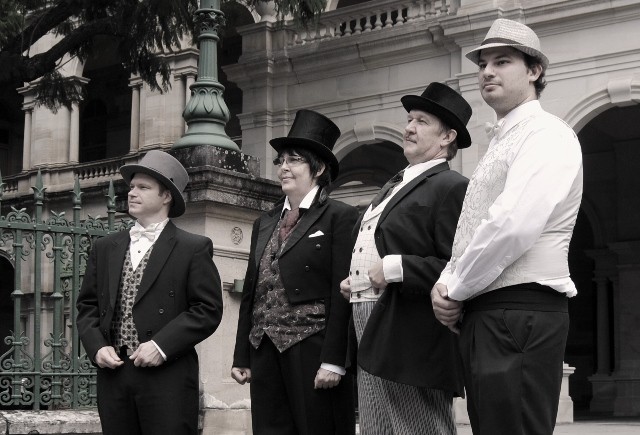
The Brisbane Band 1857 recreation concert Brass on the Grass will take place at the Brisbane Botanic Gardens on Sunday 28th of April 2013 at 3:00 pm. The Brisbane Band 1857 performance will be followed by the Brisbane City Big Band which is a subgroup of the Brisbane City Concert Band, the oldest continuously established band in Brisbane. There will also be a preview concert as part of the State Library's Tea and Music series on Tuesday 19th of March at 10:30 am at the State Library. This concert will feature music from the first concert together with information and anecdotes.
Simon Miller - Library Technician, State Library of Queensland
Comments
Your email address will not be published.
We welcome relevant, respectful comments.